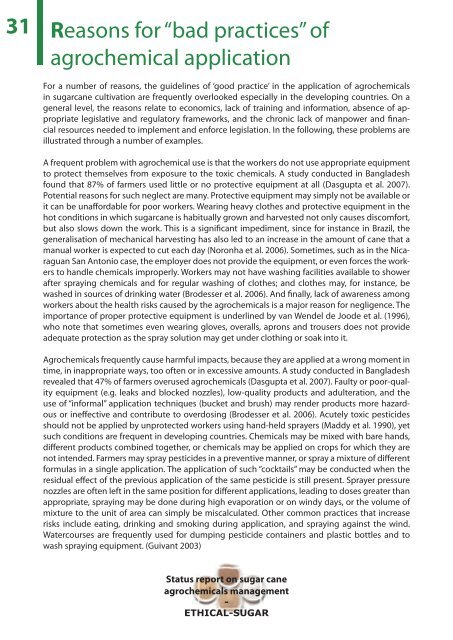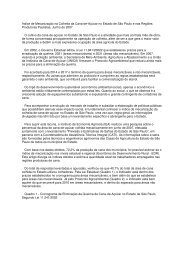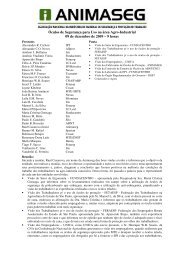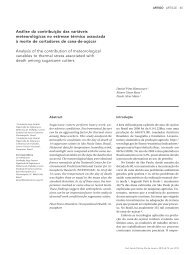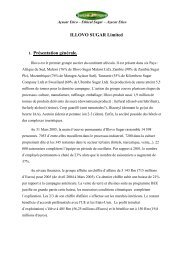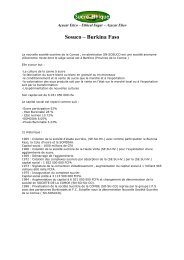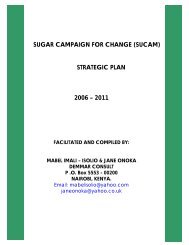Status report on sugar cane agrochemicals ... - Sucre Ethique
Status report on sugar cane agrochemicals ... - Sucre Ethique
Status report on sugar cane agrochemicals ... - Sucre Ethique
You also want an ePaper? Increase the reach of your titles
YUMPU automatically turns print PDFs into web optimized ePapers that Google loves.
31<br />
Reas<strong>on</strong>s for “bad practices” of<br />
agrochemical applicati<strong>on</strong><br />
For a number of reas<strong>on</strong>s, the guidelines of ‘good practice’ in the applicati<strong>on</strong> of <strong>agrochemicals</strong><br />
in <strong>sugar</strong><strong>cane</strong> cultivati<strong>on</strong> are frequently overlooked especially in the developing countries. On a<br />
general level, the reas<strong>on</strong>s relate to ec<strong>on</strong>omics, lack of training and informati<strong>on</strong>, absence of appropriate<br />
legislative and regulatory frameworks, and the chr<strong>on</strong>ic lack of manpower and � nancial<br />
resources needed to implement and enforce legislati<strong>on</strong>. In the following, these problems are<br />
illustrated through a number of examples.<br />
A frequent problem with agrochemical use is that the workers do not use appropriate equipment<br />
to protect themselves from exposure to the toxic chemicals. A study c<strong>on</strong>ducted in Bangladesh<br />
found that 87% of farmers used little or no protective equipment at all (Dasgupta et al. 2007).<br />
Potential reas<strong>on</strong>s for such neglect are many. Protective equipment may simply not be available or<br />
it can be una� ordable for poor workers. Wearing heavy clothes and protective equipment in the<br />
hot c<strong>on</strong>diti<strong>on</strong>s in which <strong>sugar</strong><strong>cane</strong> is habitually grown and harvested not <strong>on</strong>ly causes discomfort,<br />
but also slows down the work. This is a signi� cant impediment, since for instance in Brazil, the<br />
generalisati<strong>on</strong> of mechanical harvesting has also led to an increase in the amount of <strong>cane</strong> that a<br />
manual worker is expected to cut each day (Nor<strong>on</strong>ha et al. 2006). Sometimes, such as in the Nicaraguan<br />
San Ant<strong>on</strong>io case, the employer does not provide the equipment, or even forces the workers<br />
to handle chemicals improperly. Workers may not have washing facilities available to shower<br />
after spraying chemicals and for regular washing of clothes; and clothes may, for instance, be<br />
washed in sources of drinking water (Brodesser et al. 2006). And � nally, lack of awareness am<strong>on</strong>g<br />
workers about the health risks caused by the <strong>agrochemicals</strong> is a major reas<strong>on</strong> for negligence. The<br />
importance of proper protective equipment is underlined by van Wendel de Joode et al. (1996),<br />
who note that sometimes even wearing gloves, overalls, apr<strong>on</strong>s and trousers does not provide<br />
adequate protecti<strong>on</strong> as the spray soluti<strong>on</strong> may get under clothing or soak into it.<br />
Agrochemicals frequently cause harmful impacts, because they are applied at a wr<strong>on</strong>g moment in<br />
time, in inappropriate ways, too often or in excessive amounts. A study c<strong>on</strong>ducted in Bangladesh<br />
revealed that 47% of farmers overused <strong>agrochemicals</strong> (Dasgupta et al. 2007). Faulty or poor-quality<br />
equipment (e.g. leaks and blocked nozzles), low-quality products and adulterati<strong>on</strong>, and the<br />
use of “informal” applicati<strong>on</strong> techniques (bucket and brush) may render products more hazardous<br />
or ine� ective and c<strong>on</strong>tribute to overdosing (Brodesser et al. 2006). Acutely toxic pesticides<br />
should not be applied by unprotected workers using hand-held sprayers (Maddy et al. 1990), yet<br />
such c<strong>on</strong>diti<strong>on</strong>s are frequent in developing countries. Chemicals may be mixed with bare hands,<br />
di� erent products combined together, or chemicals may be applied <strong>on</strong> crops for which they are<br />
not intended. Farmers may spray pesticides in a preventive manner, or spray a mixture of di� erent<br />
formulas in a single applicati<strong>on</strong>. The applicati<strong>on</strong> of such “cocktails” may be c<strong>on</strong>ducted when the<br />
residual e� ect of the previous applicati<strong>on</strong> of the same pesticide is still present. Sprayer pressure<br />
nozzles are often left in the same positi<strong>on</strong> for di� erent applicati<strong>on</strong>s, leading to doses greater than<br />
appropriate, spraying may be d<strong>on</strong>e during high evaporati<strong>on</strong> or <strong>on</strong> windy days, or the volume of<br />
mixture to the unit of area can simply be miscalculated. Other comm<strong>on</strong> practices that increase<br />
risks include eating, drinking and smoking during applicati<strong>on</strong>, and spraying against the wind.<br />
Watercourses are frequently used for dumping pesticide c<strong>on</strong>tainers and plastic bottles and to<br />
wash spraying equipment. (Guivant 2003)<br />
<str<strong>on</strong>g>Status</str<strong>on</strong>g> <str<strong>on</strong>g>report</str<strong>on</strong>g> <strong>on</strong> <strong>sugar</strong> <strong>cane</strong><br />
<strong>agrochemicals</strong> management<br />
-<br />
ETHICAL-SUGAR


